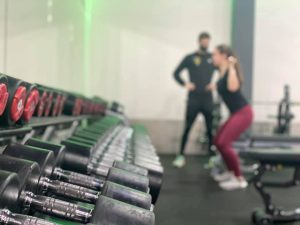Article content
When you experience knee pain while running, you quickly think of a runner’s knee. This aptly named is a common condition among runners and athletes whose knees are subjected to a lot of stress. The overuse of the knees causes an inflammatory reaction at the site of the pain. This phenomenon is also known internationally as a runners knee. It is a painful condition, negatively affecting the runner’s performance. In addition, the injury can last a very long time if you continue to train with the pain or through the pain for a long time.
Do I have a runner's knee?
The symptoms of a runner’s knee are described as pain on the front and outside of the knee, localized swelling, a stabbing or nagging pain, limited mobility of the knee joint and a feeling of instability. For example, the pain may get worse while climbing stairs or walking up an incline. In some cases, runners may hear a snapping sound when bending their knee. If the symptoms are very intense, you may feel a sharp pain nonstop at a certain angle. Then trouble may even occur with every step while running, every rotation while cycling or every repetition during a squat. In medical terms, this injury is called a tractus iliotibial friction syndrome, TITFS for short.
Diagnosis of this knee condition is done by a physical therapist or physician based on the patient’s symptoms, physical examination and medical history. The doctor may also use imaging techniques, such as MRI or ultrasound, to diagnose the condition. Usually an examination by a physician or physical therapist without imaging studies (MRI or ultrasound) is enough to be as good as certain of the diagnosis. An ultrasound can be done to be 100% sure, since you obviously cannot see through the skin as a doctor or physio. In addition, if the symptoms are somewhat unclear and if another cause of the symptoms is suspected, an MRI can be made to make sure what is causing the symptoms.
The treatment of a runner's knee
Treatment for this knee injury includes rest and physical therapy. Rest is often symptom relief and if when the symptoms are gone, you start building up in the same way, there is a good chance the injury will return.
Giving the knee adequate rest is important for recovery and also the first phase of the recovery process. The inflammation/irritation will start to decrease and there will be less friction between the bone in the knee and the tendon of the tractus iliotibialis (hence the name tractus iliotibialis friction syndrome). Another way to reduce friction is to stretch or loosen muscles (with a foam roller, massage gun or by a physical therapist) of the ones that attach to the tractus iliotibialis. Caution! Do not massage and push on the sore itself, this will only make it worse.
Through physical therapy, you can figure out the cause of runner’s knee. This can vary greatly in cause. Think of wrong shoes, stuck joints, an incorrectly learned walking pattern, specific weakness in muscles and much more. In addition, a physical therapist can also help you get rid of symptoms. Through an extensive examination, the physical therapist will work with you to determine the cause. Think of an examination of your running or training pattern, going through your running training (think of duration, intensity, how often etc.), position of your feet, wear of your running shoe, stuck joints and muscles and much more. Based on the cause, a targeted treatment is proposed to get rid of the injury, but most importantly never to let it come back. During treatments, manual operations, advice and targeted training are used to achieve this, among other things.
Preventing a runner's knee
You can do a lot yourself to prevent runners’ knees. This starts with your outfit. Make sure you use running shoes purchased from a specialized store. Stores like RunX, All4Running and Runnersworld do a running analysis to see what type of shoe fits your feet, running style and intensity of running.
In addition, make sure you have a good warm-up. Start by stretching your back, hips and legs. To experience the best effect, you want to hold the stretch for each muscle for at least 40 seconds. I personally always specify a minute, because then you can be sure it’s enough! 🙂
It is wise to seek preventive advice from a specialist in your sport or a physical therapist with experience in the sport if you are not familiar with how to build up. They can tell you how much rest you should keep between your workouts et cetera.
Often inexperienced athletes build up in distance, weight and pace too quickly in subsequent workouts. In addition, too little consideration is given to rest between workouts. It is difficult to give a global recommendation for build-up and rest, as many variables are important for this. Moreover, a runner’s knee does not only occur during running.
Exercises for a runner's knee
Although it’s very rough advice, certain balance and strength exercises can help make your muscles more taxable/resilient to a load in running, for example. For now, we’ll focus on running for a moment. If we look at the mechanics of how this running injury occurs, we see that a combination of poor running technique, decreased balance and decreased strength and load capacity in the core, hips, thighs, calves and tendons from around the knee can be a cause. This is trainable. I say in advance that I recommend doing the exercises on non-running days so that you are properly recharged and recovered for your running day.
Stretching the muscles before running
First, it is important that your muscles have sufficient length. The moment you have very shortened muscles, tendons come under more stress which can cause injuries. To prevent a runners knee, make sure you stretch at least the following muscles (For more information on imagery for the exercises, see the end of the blog):
- Bilge muscles;
- Groin;
- Muscles on the front of your hip;
- Upper leg muscles at the front;
- Upper leg muscles at the back;
- Calves.
Combination of strength and stability
Next, it is important to make the muscles strong enough to be used during running. This way, the tendons and muscles will come under the least amount of stress during the running itself, so the strain will not become too much. To prevent runners knee, we would like to recommend doing the following exercises at least twice a week, where the first three exercises may be performed 3×10 repetitions per side and the last exercise may be held for 4×30 sec.
- Side plank where the knee and hip of the upper leg may be bent and extended;
- Make a bridge and take turns extending one leg (upper legs and both hips remain at equal height);
- Side step, where there may be slow and controlled up and down movement;
- Wall sit/seated squat. Is 30 seconds too heavy? Then you can go a little shallower or hold it shorter.
Running technique
Running technique exercises can be considered both training and warm-up. You want to show your brain what good running technique means, and since there is little to no muscle damage with these exercises, you can even do them several times a day, with a rest of at least four hours. Don’t overdo it though, if you do the exercises every day, you are already doing super well. Keep to 3×20 repetitions:
- Handball jumps;
- Fast step up, ending with your floating knee in front of the hip of this leg and standing on the toes of your other leg;
- Knee lifts at an accelerated pace;
- Superman alternates between left and right.
The conclusion
A runners knee is a common injury among runners and athletes who receive high impact injuries to their knees. It is important to know exactly what is going on, how it is caused, how it is diagnosed and how it can be treated.
Prevention, of course, is best. You can do that by proper warm-up, appropriate running shoes, proper running technique and avoiding overuse.
When developing a treatment and prevention plan, it is important to consider the individual circumstances and specific needs of each athlete. In general, it is important to act early on symptoms and take treatment as well as prevention seriously to prevent further complications and protect the athlete’s performance and well-being from further decline.
You can always contact us for more information. Think about footage for the exercises, a question about this article or an appointment with one of our physical therapists to work on your injury! 🙂










